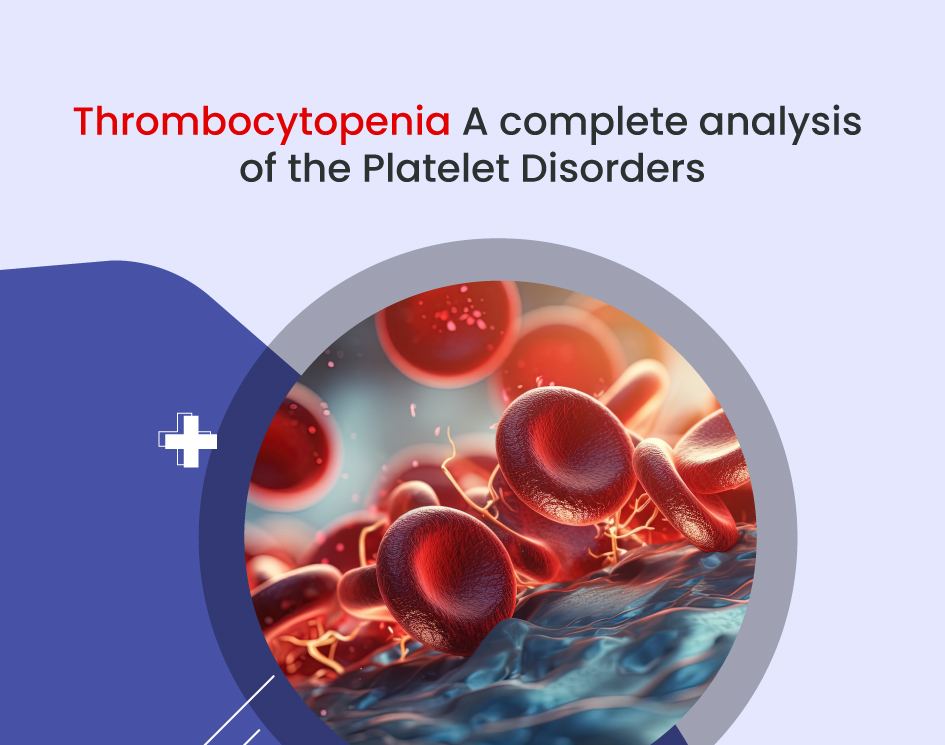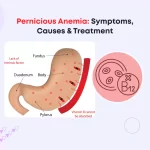
Thrombocytopenia: A complete analysis of the Platelet Disorders
Thrombocytopenia is a decrease in the number of platelets in the blood to a level less than 150,000 platelets per microliter of circulating blood. Platelets are responsible for blood clotting and stopping bleeding. They stick to the damaged wall of the vessel and stick together, forming a loose white blood clot. Then, under the action of substances contained in platelets and in blood plasma, fibrin protein filaments are formed, erythrocytes settle on them, and as a result, a dense red thrombus is formed on the basis of the primary white thrombus.
When platelet count is low, blood clotting slows, increasing the risk of bleeding in many body areas. As a result, understanding the probable causes and symptoms of low platelets is critical for detecting this dangerous scenario.
Causes of thrombocytopenia
Low platelet counts, or thrombocytopenia, can be brought on by problems with platelet production, spleen-related pooling, or excessive consumption. This disease is caused by several conditions, including:
- Abnormal bleeding tendencies are brought on by inherited conditions such Bernard-Soulier syndrome, May-Hegglin syndrome, and TAR syndrome.
- Conditions that prevent the generation of platelets include bone marrow issues, cancer, leukemia, toxicology responses, and alcohol usage.
- Diseases include immunological illnesses and disseminated intravascular coagulation (DIC) that rapidly consume platelets.
- Spleen enlargement because it removes a lot of red blood cells and overburdens the bone marrow by storing platelets.
- Systemic lupus erythematosus and encephalomyelitis are two examples of disorders with autoimmune issues in which the immune system destroys platelets.
- Medications, particularly extended use of cytostatics, might injure platelets and impair their production.
Forms and degrees of thrombocytopenia
Platelets are the building blocks of blood. They are produced from megakaryocytes, which are processed by the bone marrow. Megakaryocytes are large cells with numerous long processes. As they mature, they separate and enter the bloodstream. Up to 800 platelets are obtained from one megakaryocyte cell. Platelets look like nuclear-free flat plates, the size of which does not exceed 1-2 micrometers.
Thrombopoietin, a hormone made in the liver, muscles, and kidneys, drives megakaryocyte production. The substance synthesis slows when the platelet count rises, aiding platelet level control.
When thrombopoietin production halts due to issues, platelet count drops, causing thrombocytopenia. Various forms of this condition are recognized by doctors:
- Autoimmune- The immune system begins to perceive its own platelets as foreign objects and attacks them. The body itself destroys these blood cells;
- Essential – Essential thrombocythaemia mostly occurs in people over 50 years of age due to a lack of iron, diseases of internal organs, surgeries;
- Thrombocytopenic purpura- It is usually diagnosed in children, mainly in girls. Develops due to disorders in blood clotting;
- Thrombocytopenia of the newborn- It is formed due to congenital pathologies, infection of infants, and premature birth.
It is customary to divide thrombocytopenia according to severity. She may be:
- Easy- The platelet count is at the lower limit of the norm, while there are no manifestations of the disease. The disease is diagnosed by chance, often during a planned medical examination;
- Medium- The concentration of red blood cells is below normal. A person may complain of extensive hematomas with light strokes and nosebleeds. The greatest danger is the threat of internal bleeding;
- Heavy- A significant lack of platelets in the blood. It is manifested by extensive hemorrhages in the internal organs.
Symptoms of thrombocytopenia
- In both children and adults, grade 1 thrombocytopenia may be asymptomatic and is often discovered incidentally. But although there are no external manifestations, this stage of thrombocytopenia is dangerous because the problem can progress.
- At the 2nd degree, blood clotting is already significantly reduced, and hemorrhagic syndrome begins to appear, i.e., bleeding syndrome. At this stage of thrombocytopenia, the so-called purpura appears – a scattering of small-pointed, up to 2-3 mm, hemorrhages on the mucous membranes and skin, more often on the limbs. There may be bruising after very slight bruising, bleeding gums, bleeding from the nose, very long and heavy periods, and prolonged bleeding after cuts.
- At the 3rd degree, hemorrhages in various organs are possible, including hemorrhagic stroke – a hemorrhage in the brain. Blood may appear in the urine and stool.
Diagnosis of thrombocytopenia
For both children and adults, thrombocytopenia is dangerous because it can cause hemorrhages in the internal organs. Therefore, if any signs of thrombocytopenia appear, you should immediately consult a hematologist. First, he will prescribe a general blood test. If this test shows a low platelet count, further testing will be needed to find the source of the problem. May be required:
- biochemical blood test ;
- coagulogram ;
- analysis for antibodies to platelets;
- tests for viral hepatitis, HIV, and other infections;
- analysis for the level of vitamin B12 in the blood;
- spleen and liver ultrasound;
- consultations of a hepatologist, rheumatologist, and oncologist ;
- if indicated, bone marrow puncture.
Unfortunately, sometimes it is not possible to find the cause. In this case, the diagnosis will sound like this: “Thrombocytopenia, unspecified.”
Treatment of thrombocytopenia
Patients often obtain therapy for Grade 1 and 2 thrombocytopenia without having to remain in the hospital. However, hospital admissions are typical for Grade 3 students. Hospitalization is required if the platelet count falls to 20 109/l or below or if there is significant bleeding in addition to any platelet count.
The patient’s level of thrombocytopenia and whether it is the primary problem or the result of another factor will determine the treatment strategy. It also matters if it was brought on by a separate condition, such as another sickness. Usually, the primary illness responsible for the problem is the focus of the therapy strategy. However, glucocorticosteroids are frequently used. Immunoglobulins and thrombopoietin receptor activators are added as necessary. When cancer-related chemotherapy or radiation is to blame, the problem is resolved.
In tough cases, when medicine doesn’t help, the spleen might be removed, and platelet mass is given through a vein.
Key Points
Thrombocytopenia, characterized by low platelet counts, poses risks of bleeding and organ damage. Thrombocytopenia’s potential severity necessitates constant medical monitoring and timely intervention for an improved prognosis. For accurate diagnosis and tailored care, it’s essential to rely on specialized medical guidance. Don’t hesitate to consult a hematologist for a comprehensive evaluation and personalized treatment.








